Something you learn early on in streaming, usually before you sit in front of the camera, is that quality is important.
A charismatic streamer can have their chances dashed with subpar audio quality, and the wrong equipment, and crystal clear video may be the deciding factor in donations or subs.
The best setup for streaming doesn’t need to empty your life savings, but it will require an investment. We’re here to help you understand why certain items pay off and what your best options are.
Streaming Setup Essentials
Before you run out and purchase all the complementary gear for streaming, make sure you have your basics covered. This includes:
- Something to stream from (PC, Mac, gaming console, or smartphone)
- An idea of what you want to stream (this affects what specific items you get and how much power you need)
- Stable and fast internet connection (upload speeds of at least 5 Mbps, ideally higher)
Once you have this all figured out, it’s time to look into components that boost your stream quality. In theory, you could get started with your laptop webcam and a pair of headphones with a mic, but the truth is that streaming is too competitive for subpar quality.
Bumping up your video and audio quality is the quickest way to attract and retain reviewers, and it makes it much easier for you to interact with your audience. Depending on your budget, accessories can build on this quality, improve navigation, and add fun features to your stream.
Video Source Options
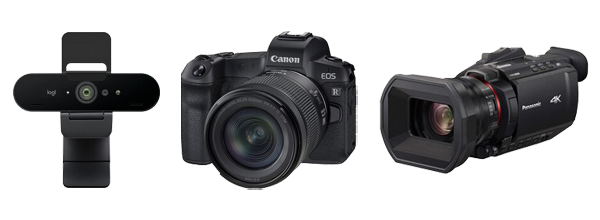
Video is one of the most important details to get right if you want a professional appearing stream. While most entry-level options are fine, you want to make sure you don’t look like you’re shooting on the original iPhone.
In this section, look for:
- Webcams: But not usually the one that comes stock with your laptop or monitor. These are perfect for minimizing clutter on your desk and keeping costs low, but insufficient research leads to subpar quality.
- Mirrorless or DSLR Cameras: The ideal choice for most streamers, but an attainable goal for most. These are versatile and provide fantastic results, but you’ll need extra power for an encoder to translate the video properly.
- Camcorders: Your best option if 4K streaming is your goal or if you pursue other visual content. Camcorders create professional videos and are powerful enough to tackle anything.
If you’re looking to stream on the go, an action camera like a Go-Pro is a better idea. These are great for immersive shots that hold up against rugged content.
Keep in mind that video quality and lighting go hand-in-hand. Getting a camera with great low-light performance only goes so far, so you should budget for at least a ring light or key light to keep everything vibrant.
Audio Source Options
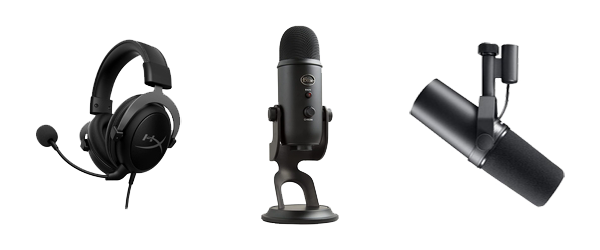
The next detail to consider is how your stream sounds, specifically how you sound while you’re streaming. Your gameplay and video content should come through crystal clear, but a muffled mic will lead to confusion.
Your options here include:
- Built-in microphones: Usually built into your webcam or headphones. Quality varies, so it’s important to do your research and make sure all areas are covered.
- USB microphones: A step up from those built-in. These usually have greater range and customization, and they’re fairly inexpensive.
- XLR microphones: The best sound quality with the best adjustments available. You can tweak them to create the exact sound that you want, but you need an audio mixer to use them for your stream.
Working with your headset mic is fine in a pinch and usually provides acceptable sound, but a separate mic for your stream prevents cross-talk and opens the door for more customization.
An audio mixer lets you combine sounds from multiple sources, such as your stream and an XLR microphone, and it makes it much easier to manage your sound settings. These are priced low enough that even those on a budget can find one to make life easier.
Helpful Streaming Accessories
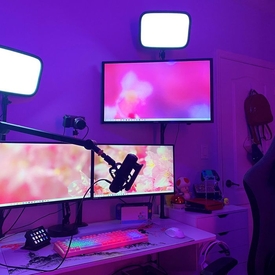
Image: nymag.com
Streaming accessories aren’t at the top of the list, but they’re usually a nice investment.
For example, a stream deck is increasingly regarded as a staple for streaming. Many of the fancy features that pop up in your favorite streams are triggered by a single button press, and you don’t need to worry about scrambling through controls to make small adjustments.
Green screens can create a more suitable streaming background (especially if you’re streaming out of a small or shared space) or they can bring variety to your stream.
Other things to consider include:
- Different mounts (arms and tripods) for your cameras and microphones
- Different cables (colors, materials, lengths) to connect all your sources
- Cable management systems
- Additional lighting (LED strips for ambiance, interactive light panels, floodlights)
Any accessory that helps you get the job done and feel better about your streaming setup is usually worth the investment, but make sure you do proper research first.
Best Streamer Setups
You can try to search for all these items on your own separately, but that’s quite the daunting task. Luckily, we’ve done some heavy lifting to get you started.
Our recommendations are split into two categories based on experience and budget, but these aren’t constraining categories.
In the end, you want to choose whichever items fit your budget and the setup you’re going for, and you can always dabble in both.
1. Beginner Streaming Setup
A beginner streaming setup should cover all the basic items you need for a high-quality stream. This includes:
- Microphone
- Headphones
- Webcam
- Lighting
- A capture card
- A stream deck
You may already have some of these lying around, and you can find good quality options at low prices. These help you reach quality consistent with most of your serious competitors.
Microphone
One of the best things you can do is get a standalone microphone to improve your streaming audio and separate it from other sources (especially if you’re gaming).
 Logitech’s Blue Yeti USB Microphone comes in several color options and carries the reliability of the brand. It might push your budget a bit, but offers plenty of controls you don’t normally see in microphones at this price.
Logitech’s Blue Yeti USB Microphone comes in several color options and carries the reliability of the brand. It might push your budget a bit, but offers plenty of controls you don’t normally see in microphones at this price.- The SoloCast, a USB condenser mic from HyperX, comes highly recommended as well. Some people start here and never see the need to upgrade, saving them quite a bit right off the bat. Plug and playability is fantastic, and you don’t miss out on high-resolution sound.
Headphones
Headphones come second in audio quality needs, but they’re still a priority. Noise cancellation and directional sound increase your immersion, leading to better performance and a more satisfactory stream.
 Whenever possible, we recommend studio-quality headphones like the Sennheiser HD 599. These are more comfortable for extended wear and maintain superior sound quality. They’ll keep you gaming for longer without cramping your style.
Whenever possible, we recommend studio-quality headphones like the Sennheiser HD 599. These are more comfortable for extended wear and maintain superior sound quality. They’ll keep you gaming for longer without cramping your style.- HyperX Cloud II headsets veer closer to the traditional gaming aesthetic, and they present a headset for in-game communication. While they’re a fraction of the price, they prioritize comfort, quality, and durability.
Webcam
Webcams have come a long way (especially after the remote working boom in 2020), and it’s easy to find a high-quality return on a lower investment.
 Logitech’s C920x Pro HD brings you up to 1080p quality and 30fps for streaming, and its integrated mics can help you cut costs in a pinch. Features like automatic low-light correction can help you stay on top of adjustments.
Logitech’s C920x Pro HD brings you up to 1080p quality and 30fps for streaming, and its integrated mics can help you cut costs in a pinch. Features like automatic low-light correction can help you stay on top of adjustments.- Another great multitasker is the Razer Kiyo. You can reach the same 1080p resolution and 30fps with the Kiyo, and you don’t have to worry about finding room for a ring light somewhere in front of you. It really brings “low light correction” to the next level.
Lighting
Odds are, you aren’t creating a streaming setup on your back deck. To compensate for the lack of lighting and give your camera a fighting chance, you need at least a cheap ring or key light.
- The UBeesize 12” Right Light distributes light evenly, and it’s the perfect size for both power and efficiency. It won’t heat up around the other devices, and you can mount your phone or camera directly on the light.
 For more directional or diffused lighting, this ULANZI K7 Key Light has you covered. It uses edge-lit technology for a softer touch, creating a more natural environment. The slim profile fits perfectly almost anywhere, and you can get some really pleasant effects.
For more directional or diffused lighting, this ULANZI K7 Key Light has you covered. It uses edge-lit technology for a softer touch, creating a more natural environment. The slim profile fits perfectly almost anywhere, and you can get some really pleasant effects.
Capture Card
You can’t really beat Elgato capture cards, and adding the HD60 S+ to your setup:
- Reduces the workload on your PC
- Ensures high quality video
- Reduces lagging in your video transmission
These come into play mostly when someone is using anything other than a single PC for streaming. It’s also a great tool for reflection and you can create great content to promote your stream on other sites.
Stream Deck
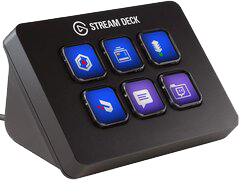 Elgato also reigns supreme when it comes to stream decks. While a stream deck follows the idea of setting up macros for your stream, it’s well worth the money for the extra device instead of reprogramming your existing keys.
Elgato also reigns supreme when it comes to stream decks. While a stream deck follows the idea of setting up macros for your stream, it’s well worth the money for the extra device instead of reprogramming your existing keys.
The Stream Deck Mini is a great budget option with 6 programmable LCD keys, endless storage space, and native integration with programs you probably have close at hand. Control overlays, sound effects, Spotify, or even smart come controls with only a few taps.
Advanced Streaming Setup
An advanced streaming setup should cover all the basics and then some. This type of setup is what you look to only after you’ve made the initial steps in improving stream quality.
If you’re at this point, you’re looking for:
- Higher tier options (for mics, headphones, cameras, lighting, capture cards, or stream decks)
- Accessories for existing equipment
- Additional hardware, such as audio mixers
Keep in mind that you don’t need to go all out and check every box in this area. If you can only afford a new camera, that’s the perfect place to start. Every investment moves you forward.
Microphone
You don’t need a stage microphone that can take a beating, but advanced streamers can achieve richer tone and better background noise cancellation with a high quality mic.
 Cardioid mics like the Shure SM7B do a great job of picking up only what you lay down. They focus on sound coming from the front, and this specific mic sits at the angle most comfortable for you. Electromagnetic shielding makes it a great choice to use around computers or other equipment.
Cardioid mics like the Shure SM7B do a great job of picking up only what you lay down. They focus on sound coming from the front, and this specific mic sits at the angle most comfortable for you. Electromagnetic shielding makes it a great choice to use around computers or other equipment.- The AT2035 also follows a cardioid polar pattern that rejects background noise and isolates your voice. Making the leap easily captures nuances in tone that your audience learns to expect.
Mic Arm
While you’re making microphone adjustments, it’s a good time to look into a mic arm. This lets you place the mic in a more convenient and effective location. Most mic arms are universal.
- The Elgato Wave provides better range and works perfectly with dual monitor setups. It handles both heavier mics and thicker desktops while maintaining smooth, silent motion, and secure positioning.
 The Rode PSA1+ Pro is another fan favorite. With near-perfect reviews, you get the professional positioning that you need. An innovative spring design paves the way for accurate placement, and the integrated cable management clears the clutter.
The Rode PSA1+ Pro is another fan favorite. With near-perfect reviews, you get the professional positioning that you need. An innovative spring design paves the way for accurate placement, and the integrated cable management clears the clutter.
Mixer
An audio mixer is essential for anyone using a mic with an XLR plug, but everyone can benefit. Mixers give you greater control over all your inputs, allowing you to tune different channels and even mute certain lines.
 The GoXLR from TC Helicon is one of the most recommended mixers on the market, and it’s designed perfectly for gaming. You get customizable lights, plenty of line-in options, and well-spaced manual controls. The accompanying software only improves on this, and this will magnify stream quality.
The GoXLR from TC Helicon is one of the most recommended mixers on the market, and it’s designed perfectly for gaming. You get customizable lights, plenty of line-in options, and well-spaced manual controls. The accompanying software only improves on this, and this will magnify stream quality.- Elgato’s Wave XLR Audio Mixer is a respectable alternative to the GoXLR, and provides the power you need for XLR mics, tap-to-mute controls, and integrates seamlessly to their Wave Link App for audio mixing. The Wave XLR comes with Clipguard technology and a studio-grade preamp to boost your mic and drive audio quality.
Headphones
Your advanced headphones boost sound quality even more and feel the best over extended sessions.
 Many streamers choose beyerdynamic DT 990 Pros for their streaming setup simply for the directional sound and superb feel. If you’re sensitive to the pressure from wearing a headset, these might solve your problem.
Many streamers choose beyerdynamic DT 990 Pros for their streaming setup simply for the directional sound and superb feel. If you’re sensitive to the pressure from wearing a headset, these might solve your problem.- If you’re not a fan of the studio-style for headsets or want a wireless headset, the SteelSeries Arctis 7P+ combines that level of quality with a sleek gaming aesthetic. These were specifically designed for PlayStation and use award winning sound technology to give you the edge you need.
Camera
Your camera upgrade is usually the first thing you consider when bumping up quality. This is also one of the most expensive upgrades, so take your time with research.
 You can stick with a webcam and still get 4K resolution for your stream with the Logitech Brio 4K. It’s also worthwhile for bumping up your FPS on a 1080p stream.
You can stick with a webcam and still get 4K resolution for your stream with the Logitech Brio 4K. It’s also worthwhile for bumping up your FPS on a 1080p stream.- A mirrorless camera like the Sony Alpha a6000 provides the steepest quality climb without eating up your desk space. This outperforms top-tier webcams with its low-light capabilities and improved image quality, and you can take it with you for great still shots.
Lighting
There are plenty of entry level lights for streaming that get you along, but advanced options are simply brighter and more reliable.
- The Elgato Key Light illuminates your space with 2,800 lumens, or you can tone it down for a more subtle effect. OSRAM LEDs provide superior quality to nameless technology, and you get a more balanced look without swamping your streaming space.
 High quality lights like the Logitech Litra Bream focus on keeping colors true. Cheaper lights might wash you out or turn you yellow, but full-spectrum LEDs help maintain color accuracy.
High quality lights like the Logitech Litra Bream focus on keeping colors true. Cheaper lights might wash you out or turn you yellow, but full-spectrum LEDs help maintain color accuracy.
Green Screen
Not everyone needs a green screen, but those that want it should treat it as an investment. The Elgato Green Screen is more than a green sheet hung behind you. The thick, wrinkle resistant sheet limits any chroma abnormalities that would interfere with image quality.
If you’re using this in a smaller space, you’ll love the easy retractable screen and simple stowing. No tripod means a sturdier frame, and the screen won’t jump ship in the middle of your stream.
Capture Card
A high quality capture card reduces the stress on your PC and allows you to use external devices for your stream (such as a mirrorless camera). The emphasis on quality is even greater when you want 4K streaming from your devices.
The Elgato capture cards are tried and true, and they offer a sleek design for reliable pass through and simple operation.
Stream Deck
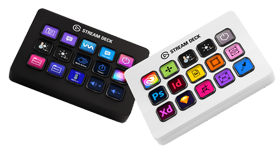 That mini Elgato Stream Deck we mentioned earlier is just the baby version of the Stream Deck MK.2. The biggest difference between the two is the number of keys (the full-size has 15), but you get the same high-quality software and compatibility with either.
That mini Elgato Stream Deck we mentioned earlier is just the baby version of the Stream Deck MK.2. The biggest difference between the two is the number of keys (the full-size has 15), but you get the same high-quality software and compatibility with either.
If the Elgato Stream Deck isn’t quite your style, the Loupedeck Live has been gaining popularity. It follows the same general idea, but has a touch screen interface and customizable control dials, compared to the Stream Deck.
FAQs
What Is a Good Setup for Streaming?
A good setup for streaming is one that covers your basics and meets your budget. Most people starting out cannot afford to buy top-tier items, but there are small purchases you can make here and there that bring an obvious enhancement to the quality of your stream.
To make sure all your bases are covered, focus on:
- Quality video
- Quality sound
- Quality content
It doesn’t matter how you get there, but investing in these areas first has the most payoff.
What Hardware Is Most Important for Streaming?
Your gaming rig is the most important hardware for your stream. Not only do you need something capable of playing the games you want to broadcast, but most want an all-in-one device that can push the stream at the same time.
Whether you’re using a console, computer, or even your smartphone, make sure you choose items that are compatible with the device and won’t overpower it. Don’t overlook proper maintenance and upgrades, or you might find yourself out of commission despite your hefty investments in audiovisual equipment.
Final Thoughts
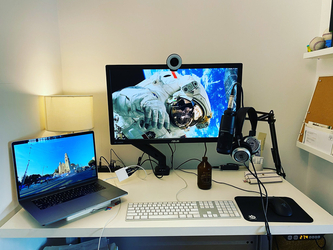
Image: Flickr
That may seem like a daunting list, so it’s important to remember you don’t need to go out and buy everything at once. You can start small with a few high-quality items (and maybe get lucky to receive something as a gift), make sure you’re down to commit, and then work your way up the ladder.
The best setup for streaming allows you to come through authentically for your audience. For some people, you may just want a good headset and mic combo for easy communication. Others want the highest quality camera to catch the beads of sweat on their forehead when that boss music kicks off.
Find out where you may need to improve, look for quality options in your budget, and go from there. Remember to stay true to yourself, enjoy your stream, and don’t get hung up on the next best thing. In most cases, you’re already doing just fine.

 Logitech’s
Logitech’s 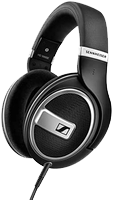 Whenever possible, we recommend studio-quality headphones like the
Whenever possible, we recommend studio-quality headphones like the 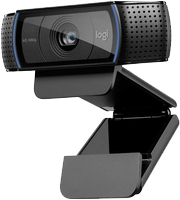 Logitech’s
Logitech’s  For more directional or diffused lighting, this ULANZI
For more directional or diffused lighting, this ULANZI 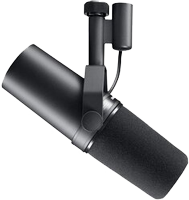 Cardioid mics like the
Cardioid mics like the 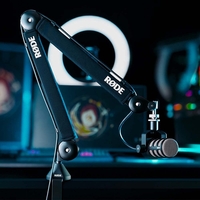 The
The 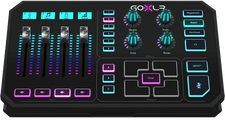 The
The 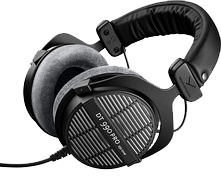 Many streamers choose
Many streamers choose 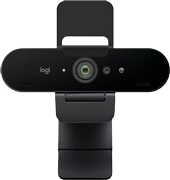 You can stick with a webcam and still get 4K resolution for your stream with the
You can stick with a webcam and still get 4K resolution for your stream with the 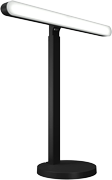 High quality lights like the
High quality lights like the 

